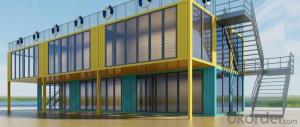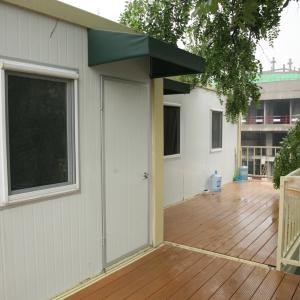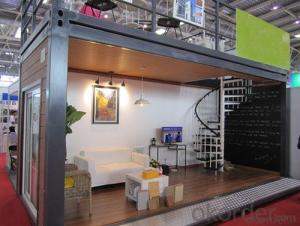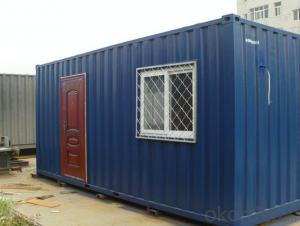Luxury 40ft shipping container prefabricated shops, shopping malls, cafes
OKorder Service Pledge
OKorder Financial Service
You Might Also Like
Specifications
1low cost modular house. low cost
2. easy installation
3 Green and environmental material
4. Power-Saved
Specifications
1. Firm structure and multiple use.
2. Lost cost and convenient in shippment.
CNBM INTERNATIONAL LOW COST PREBUILT CONTAINER HOUSES
Product description
1. Container house is a unit house with the size of 6055mm*2435mm*2740mm.
2. The container house adopts EPS, glass wool or rock wool as heat insulation material.
3. All the components are standard and prefabricated with the advantage of assembling and disassembling easily. Six skilled workers can finish three modular units in 8 hours.
4. 4sets of standard container house can be packed together to replace the shipping space of one 20ft container.
5. The container house can be linked freely at length, width and height through the linking kits for bigger structure and different layout.
6. Waterproof design of galvanized structure, fireproof and heat insulation of material ensure the house to resist heavy wind load of 0.6KN/m2and 8 degree seismic intensity.
7. The life span of the house is 20-25 years.
Characteristics
1. Cost Effectiveness
2. Chemical free, and lower waste
3. Easy to erect
4. Safety
5. Fireproof, termite free
6. Strong and durable – weatherproof, anti-seismic
7. Materials will not shrink, rot or warp
8. Pre-galvanized for rot and corrosion prevention
Benefits of factory built prefabricated houses and villas
| |
Very little maintenance | Reduce environmental pollution and save water |
Ease and speed of erection | Easily transportable |
Aesthetically pleasing | Buildings can be relocated |
Priced more economically than brick | Buildings can be designed by your choice
|
- Q:Can container houses be modified for accessibility?
- Yes, container houses can be modified for accessibility. Container houses are highly versatile and can be customized to meet specific needs, including those related to accessibility. Several modifications can be made to make container houses more accessible for individuals with disabilities or mobility challenges. Some common modifications for accessibility in container houses include: 1. Ramps and elevators: Installing ramps or elevators can ensure easy access for individuals using wheelchairs or mobility aids, eliminating barriers posed by stairs or uneven surfaces. 2. Widened doorways: Widening doorways allows for easy wheelchair access and maneuverability within the container house. 3. Grab bars and handrails: Installing grab bars and handrails in bathrooms, hallways, and other areas can provide additional support and stability for individuals with mobility issues. 4. Wheelchair-accessible bathrooms: Designing and constructing bathrooms with accessibility features, such as roll-in showers and grab bars, enables individuals with disabilities to use these facilities comfortably. 5. Adjustable countertops and cabinets: Installing adjustable countertops and cabinets allows individuals in wheelchairs to reach and use these spaces without difficulty. 6. Accessible lighting and switches: Incorporating accessible lighting options, such as motion-sensor lights or voice-activated switches, can make it easier for individuals with mobility challenges to control the lighting within the container house. It is important to consider individual needs and consult with professionals experienced in accessibility modifications to ensure that the container house is appropriately customized to meet specific accessibility requirements.
- Q:Can container houses be designed with a vertical garden or living wall?
- Yes, container houses can definitely be designed with a vertical garden or living wall. In fact, container houses provide a unique opportunity for incorporating greenery and plant life into the design. By utilizing the vertical space of the container walls, you can create a beautiful and functional living wall that not only adds aesthetic value but also provides numerous benefits. A vertical garden or living wall in a container house can help improve air quality by filtering pollutants and releasing oxygen. It can also act as a natural insulation, reducing the need for excessive heating or cooling. Additionally, the plants can absorb and retain rainwater, reducing runoff and helping with water conservation. There are various ways to design and implement a vertical garden in a container house. One option is to attach a modular green wall system to the interior or exterior walls of the container. These systems typically consist of panels or trays that hold the plants and can be easily mounted and maintained. Alternatively, you can utilize hanging pots or planters to create a cascading effect of greenery. When designing a vertical garden in a container house, it is essential to consider factors such as sunlight exposure, irrigation systems, and plant selection. Some plants thrive in low-light conditions, while others require direct sunlight. Proper irrigation is crucial to ensure the plants receive the necessary water without damaging the container structure. Additionally, choosing plants that are suitable for vertical growth and can withstand the container house environment is essential for a successful living wall. Ultimately, incorporating a vertical garden or living wall in a container house can bring a sense of nature, freshness, and sustainability to the living space. It is a creative and innovative way to utilize the limited space in container homes while promoting eco-friendly living.
- Q:Can container houses be designed to have a low-maintenance exterior?
- Certainly, container houses can be designed in a way that ensures a low-maintenance exterior. This can be accomplished through a variety of strategies and materials. To start, selecting the appropriate exterior cladding can greatly diminish the need for maintenance. Options such as fiber cement siding, vinyl siding, or metal panels are known for their durability, resistance to weathering, and minimal upkeep requirements. These materials are specifically designed to resist fading, warping, or cracking, ensuring that the exterior remains visually appealing for a longer period of time. In addition, incorporating design elements that limit exposure to the elements can help reduce maintenance demands. For instance, strategically placing overhangs or awnings can shield the exterior walls from direct sunlight, rain, and snow, thus preventing potential damage and minimizing the need for regular maintenance. Moreover, utilizing high-quality paints or coatings can extend the lifespan of the exterior and reduce the frequency of repainting or touch-ups. Opting for paints that have built-in protection against fading, UV rays, and mildew can further enhance the low-maintenance aspect of the house. Furthermore, considering the implementation of low-maintenance landscaping surrounding the container house can contribute to minimizing exterior maintenance efforts. Incorporating native plants or drought-resistant vegetation can reduce the necessity for watering, pruning, or other regular upkeep activities. Finally, integrating proper drainage systems, such as gutters and downspouts, can effectively redirect water away from the exterior walls, preventing water damage and decreasing maintenance requirements. By thoughtfully selecting materials, incorporating protective design elements, utilizing high-quality finishes, considering low-maintenance landscaping, and implementing proper drainage systems, container houses can be designed to have a low-maintenance exterior while still maintaining an attractive appearance.
- Q:Can container houses be rented or leased?
- Yes, container houses can be rented or leased. Many people choose to rent or lease container houses as an affordable and flexible housing option.
- Q:Are container houses safe from extreme weather conditions?
- Container houses have the potential to be safe and secure in extreme weather conditions, thanks to their ability to withstand hurricanes, earthquakes, and other natural disasters. By incorporating proper insulation, reinforced structures, and additional features, container homes can meet stringent building codes for high wind zones and seismic activity. The durability of container houses is one of their main advantages. Shipping containers are constructed with strong steel to withstand the harsh conditions of sea transport. This inherent strength makes them resistant to wind, rain, and even fire. However, it is important to note that modifications and reinforcements are often necessary to ensure their safety in extreme weather conditions. To provide effective thermal insulation, container homes can be insulated with high-quality materials. This insulation not only prevents heat loss or gain during extreme temperatures but also helps regulate the temperature inside the house, creating a comfortable and safe living environment. In areas prone to hurricanes or tornadoes, container houses can be further secured by anchoring them to a solid foundation or using reinforced concrete footings. Storm shutters or impact-resistant windows can also be added to protect against flying debris during severe weather events. For earthquake-prone regions, additional precautions are required. Engineers can strengthen the container structure by welding or bolting steel beams to increase stability. Proper seismic bracing and foundation design are crucial to ensure the container home remains intact during an earthquake. To ensure the construction of a safe dwelling, it is crucial to collaborate with experienced architects, engineers, and contractors who specialize in container homes. Their expertise in following proper building codes and regulations will provide a secure and reliable living space even in the face of extreme weather conditions.
- Q:Can container houses be designed with a guesthouse or granny flat?
- Yes, container houses can definitely be designed with a guesthouse or granny flat. Container houses are highly versatile and can be customized to meet various needs and preferences. By stacking or connecting multiple containers, additional living spaces can be created, such as a guesthouse or granny flat. These additional units can be designed with separate entrances, bedrooms, bathrooms, and even kitchenettes to provide privacy and independent living quarters for guests or older family members. With proper insulation, plumbing, and electrical work, container houses can be transformed into comfortable and functional guesthouses or granny flats, offering a cost-effective and sustainable housing solution.
- Q:Can container houses be financed like traditional houses?
- Yes, container houses can be financed like traditional houses. Many financial institutions offer mortgage options for container homes, allowing individuals to secure loans and purchase these alternative housing options. However, it is important to note that the process and terms may vary depending on the lender and the specific circumstances.
- Q:Can container houses be designed with a mezzanine level?
- Container houses can indeed be designed with a mezzanine level. The adaptability of shipping containers allows for imaginative and groundbreaking designs that can meet various living needs, including the inclusion of a mezzanine level. By utilizing the vertical space inside the container, it becomes possible to construct an elevated platform or a partial second floor to serve as a mezzanine. The process of designing a mezzanine level in a container house requires careful thought and planning. Structural modifications might be necessary to ensure that the container can bear the added weight. This could involve reinforcing the walls or incorporating additional support beams. Consulting a professional architect or engineer is crucial to guarantee the safety and stability of the structure. A mezzanine level in a container house can offer additional usable space, such as a loft area, bedroom, office, or storage area. It can effectively maximize the available square footage, particularly in smaller container homes. Moreover, the elevated platform can enhance the feeling of spaciousness and provide a distinctive architectural element. The design potentials for container houses with mezzanine levels are virtually limitless. There are customization options available to cater to individual preferences and requirements. Whether one desires a contemporary look or a more traditional design, a mezzanine level can be integrated to create a functional and visually appealing living space within a container house.
- Q:Are container houses suitable for remote working spaces?
- Container houses are indeed suitable for remote working spaces. One reason is their high level of customization, which allows for the creation of functional and comfortable workspaces. These houses can easily be equipped with desks, chairs, shelves, and electrical outlets, thus providing all the necessary amenities for a productive working environment. Another advantage of container houses is their portability. They can be effortlessly transported to remote locations, enabling remote workers to set up their workspace wherever they desire. Additionally, container houses are cost-effective and eco-friendly alternatives to traditional office spaces. Constructed using recycled materials, they require minimal maintenance and energy consumption. This makes container houses a great option for remote workers looking to minimize their environmental impact and cut costs. In conclusion, container houses provide the flexibility, functionality, and sustainability that are vital for remote working spaces.
- Q:Can container houses be financed or insured?
- Container houses can indeed be financed and insured. Various banks and financial institutions offer loans that are specifically designed for alternative housing choices such as container houses. These loans typically come with terms and conditions that are similar to traditional mortgages. When it comes to insurance, container houses can be insured just like any other residential property. However, it's important to keep in mind that insurance companies might have specific requirements or considerations when it comes to insuring container houses. Factors like the quality of construction, location, and safety features can affect the availability and cost of insurance coverage. To ensure that you have adequate coverage for your container house, it's advisable to seek guidance from a professional insurance agent or broker who specializes in alternative housing options. They can assist you throughout the process and help you find the insurance coverage that suits your container house.
1. Manufacturer Overview |
|
|---|---|
| Location | |
| Year Established | |
| Annual Output Value | |
| Main Markets | |
| Company Certifications | |
2. Manufacturer Certificates |
|
|---|---|
| a) Certification Name | |
| Range | |
| Reference | |
| Validity Period | |
3. Manufacturer Capability |
|
|---|---|
| a)Trade Capacity | |
| Nearest Port | |
| Export Percentage | |
| No.of Employees in Trade Department | |
| Language Spoken: | |
| b)Factory Information | |
| Factory Size: | |
| No. of Production Lines | |
| Contract Manufacturing | |
| Product Price Range | |
Send your message to us
Luxury 40ft shipping container prefabricated shops, shopping malls, cafes
OKorder Service Pledge
OKorder Financial Service
Similar products
New products
Hot products
Hot Searches
Related keywords
























